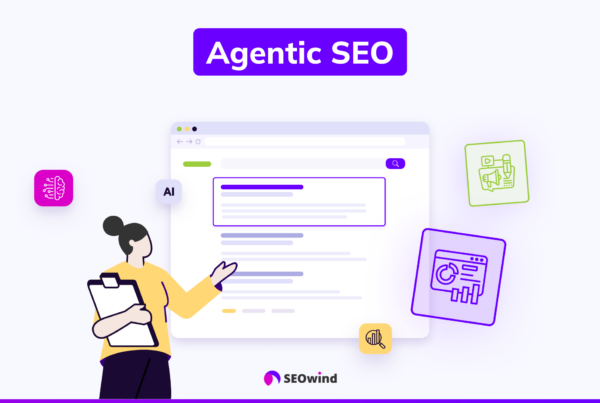Businesses are on the lookout for strategies that help them stand out from the field. An impressive website that uses dazzling graphics isn’t sufficient; understanding and implementing search engine optimization (SEO) proves far more fruitful. If that acronym sounds concerning, no worries! Let me guide you through the process of mastering SEO-based content. Let’s solve all its mysteries and explore how it could revamp your online visibility!
What is SEO content?
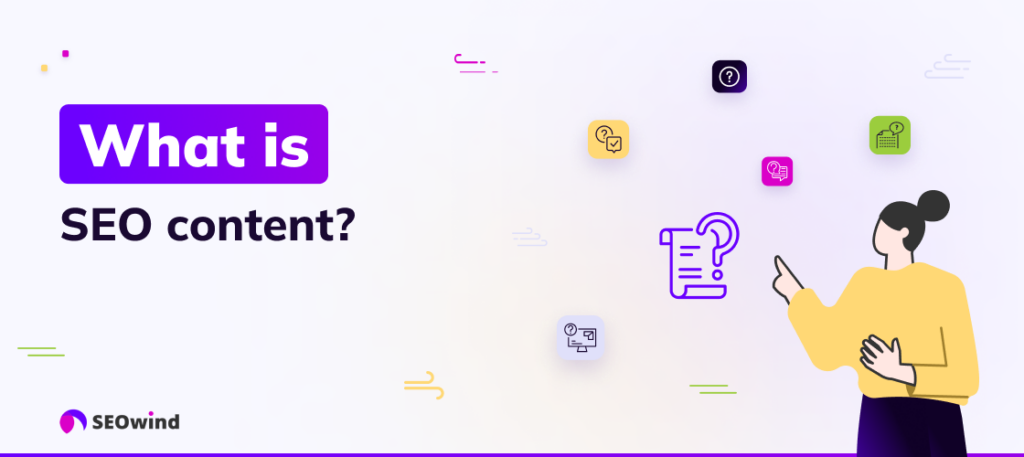
SEO-based content refers to any piece of writing crafted explicitly with search engine optimization in mind. In a nutshell, it means creating engaging and relevant content that appeals to both humans and search engines.
Creating successful SEO content comprises two main elements: appeasing search engines like Google and delivering valuable material that answers readers’ queries precisely and engages them effectively.
For businesses trying to thrive digitally, merely having an online presence won’t cut it anymore. Holding potential consumers’ interest and attracting a new audience requires rich, meaningful information embellished with effective keywords, which enhance your website’s visibility during searches.
SEO has immense potential to improve your rankings, drive traffic to your site, increase engagement levels, boost conversion rates, and much more.
Understanding search intent and how it relates to SEO content
Search intent, also known as user intent, is vital to successful SEO-based content. This is the underlying reason a person uses a search engine. Behind each keyword or set of keywords, a unique intention drives the user’s search process.
Understanding this concept allows you to craft your SEO content in a way that directly answers users’ queries and meets their needs with ease. Remembering that each visitor is unique can help shape your approach so that you can create tailored content for them.
Accurately predicting what users are looking for when they enter specific terms into Google’s search bar directly affects how high your page ranks within Search Engine Result Pages (SERPs). This is because Google prioritizes websites that provide the most relevant results based on the context implied by these search terms.
Search intent example
To illustrate this concept practically, imagine if someone types “apple” into a search engine. They could be searching for information about the fruit or curious about Apple Inc., the multinational technology company. By taking account of such semantic subtleties and including them in our SEO strategy, we stand to gain improved visibility and drive more traffic to our site.
Interestingly enough, understanding your target audience’s search intent can be challenging. However, it heavily influences your choice of SEO techniques when crafting your digital narrative piece. It affects everything from choosing which keywords to use to formatting and structuring the presented information.
Accurately capturing and addressing your audience’s core needs invariably fosters better engagement rates and higher SERP rankings. And, after all, isn’t our ultimate goal to provide valuable solutions for those visitors who trust us to resolve their queries? So, understanding user intent should be integral to any comprehensive SEO for content strategy.
Think like a reader! If you were in their shoes, would your webpage answer all potential questions they have regarding apples, both the fruity and technological kind? If the answer is yes, we’re already leagues ahead in our SEO journey. Let’s set forth with that same spirit!
So, how exactly do we unlock this intricacy of search intent? Buckle up. We’ll cover it below.
Types of SEO content: A Deeper Dive
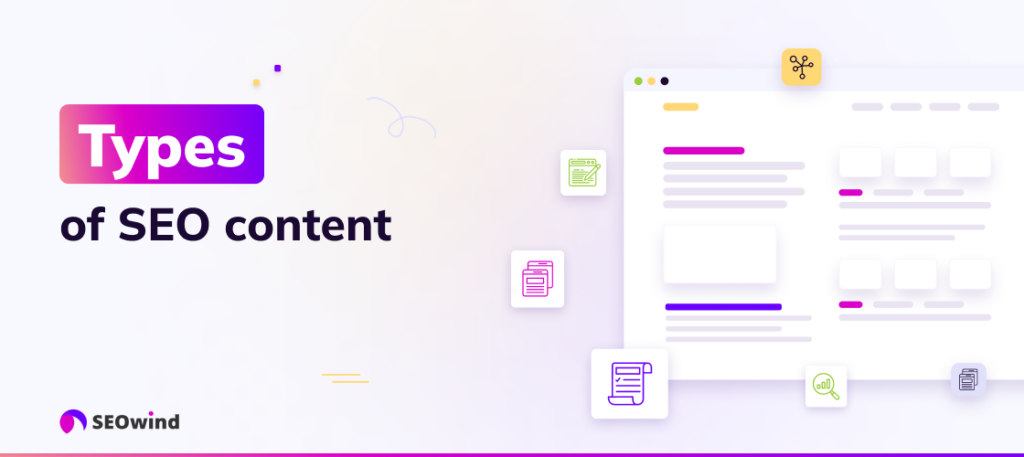
Different types of content that can be optimized for search engines
Understanding the diversity in types of SEO content is a crucial step in crafting a fine-tuned SEO strategy. It empowers writers to produce riveting narratives and value-packed articles, all while feeding the relentless algorithms that drive search engine rankings. Here are key types you should familiarize yourself with:
- Blog Posts: Blog posts are easy to update and help establish authority in your niche.
- Long-Form Articles: These pieces, often extending beyond 2000 words, provide room for detailed exploration of topics, enhancing brand credibility while capturing long-tail keywords.
- Infographics: Largely visual data-driven content can increase engagement rates and add a shareability factor to your page.
- How-To’s and Tutorials: Proving highly useful to users, this richly informative type gives ample opportunities to incorporate targeted keywords naturally.
- Listicles: Engaging and easy-to-read format boosts the user experience.
- Product/Service Pages: Crucial for businesses, these pages play a vital role in driving conversions.
Benefits and considerations for each type of SEO content
Every type of SEO-optimizable content brings benefits but also introduces certain aspects to consider carefully.
Blog Posts can position you as an industry expert, increasing trust among readers and providing an opportunity for sharing via social media. However, they require constant updating with fresh posts that maintain high-quality standards.
Long-form articles enable you to shine as an authority figure in your realm and allow you to dive deep into subjects that might hold your readers’ interest while inviting accompanying organic traffic through broad keyword coverage.
Infographics might connect to a different demographic segment that appreciates a creative presentation style. This content style boosts social shares but demands more strategic efforts for integrating SEO components.
Advisory content formats, such as how-to’s and tutorials, cater effectively to problem-solvers who need your product or service. However, extensive quality research is a prerequisite to live up to user expectations.
Publishing listicles can improve engagement due to their high readability. However, they should go beyond surface-level information to provide substantial value.
Lastly, carefully crafted product or service pages actively contribute to conversions, which is critical for any business aiming for growth. But you need to strike a balance between being informative and not coming off as too sales-y.
Acknowledging these multi-faced aspects of each type of SEO-based content allows you to make better-informed decisions that shape effective strategies.
Make your SEO-based Content E-E-A-T
High-quality SEO content extends beyond keywords and meta tags. When considering the actual worth of your content from a search engine’s viewpoint, examining the principle concepts of Experience, Expertise, Authoritativeness, and Trustworthiness (E- E-A-T) is crucial.
E- E-A-T guidelines are intrinsically wired into Google’s algorithms to distinguish high-quality content from poorly constructed or inaccurate information. Placing a priority on fulfilling these criteria can be instrumental in improving your SEO content quality.
Experience: Demonstrating the Depth of Your Real-World Involvement
Just as keywords are the heartbeat of SEO, experience is the pulse of content credibility. An author’s first-hand experience can significantly amplify the value of the content provided, as it’s a testament to their personal engagement with the subject at hand. But how do you infuse it into your SEO strategy to achieve a palpable impact? Here’s how.
Experience is all about showing, not just telling. It’s the difference between an article that comes across as a theoretical essay and one that reads like a treasure map filled with practical insights gleaned from real-world applications. Writers with genuine experience can recount scenarios, offer problem-solving techniques, or discuss trends with an authority that only comes from having been there and done that.
Fuel your content with anecdotes and case studies from your own professional journey. This enriches your narrative and allows readers to connect the dots between abstract concepts and tangible outcomes. In SEO terms, search algorithms now look for content that drives user engagement. And what is more engaging than narratives woven with authentic experiences?
Expertise: Showcase Your Proficiency
Demonstrating expertise in your area involves providing insightful, exhaustive information that goes beyond the surface level. To secure this degree of depth, you’ll require a firm grasp of your subject matter. This is where research brimming with the latest studies and cited sources come into play.
As they say, “Content is king.” I would further emphasize this by stating that knowledgeable content wears the crown. Whether you’re penning down an extensive guide or crafting a succinct blog post, each piece should leave readers more informed than before they arrived.
Authoritativeness: Cementing Your Stance as A Leader
Positioning yourself as an authority demands proof that you know what you’re talking about. You need to substantiate why you deserve to be listened to.
Another effective approach is demonstrating social proof through testimonials or case study results. Social validations add credibility and make people more likely to trust what you say, enhancing the user experience and SEO content quality.
Trustworthiness: Making Clients Believe in Your Promise
Trustworthiness primarily addresses how safe a user feels while browsing your site. It ties closely with ensuring transparency about who stands behind the site or page (personal identities, contact information, etc.) and updating content regularly.
Always keep your website secure, especially when dealing with sensitive user information. Also, enhance trust by maintaining an active presence in relevant online communities; be readily responsive and helpful.
Pillar 1: Keyword Research for SEO Content

The Importance of Keyword Research in Creating Effective SEO Content
It is impossible to overemphasize the importance of keywords. They are the linchpin between what people search for and the content you provide. When it comes to creating something valuable and easy to find on a search engine, keyword research is the first step. Understanding this will show how relevant your content is to your audience.
Analyze Search Intent
By definition, search intent refers to why someone conducts a specific online search.
- What queries are they looking for answers to?
- What information do they require at this stage?
- What purpose does their search serve?
Understanding what our potential readers might be looking for is integral to creating effective SEO content. This knowledge allows you to tailor your articles or blogs to target those needs.
Methods and Tools for Conducting Keyword Research
Numerous options, such as Google Ads’ Keyword Planner, can assist in identifying frequently used searches related to your topic. This gives you invaluable insights about high-ranking words.
Another handy option is Ubersuggest, which offers data regarding long-tail phrases and user questions.
Analyzing Competition and Finding Opportunities for Targeting Keywords
This forms another piece of our strategic puzzle where we dissect the competition’s use of targeted keywords.
We thrive off opportunities presented through competitors’ shortcomings. Identifying gaps in their keyword strategy grants us the perfect chance to step in, deliver on those exact points, and effectively draw that audience to our content.
Identifying Long-tail Keywords and Their Relevance to Search Intent
Next up is long-tail keywords. Long-tail keywords are simply longer, more specific phrases people use when they’re closer to making a purchase and indicate high intent. These keywords can build significant website traffic, often overlooked due to lower search volumes.
Being able to tactically place these key phrases throughout your SEO-based material can turbo-charge your content’s reach in ways that generic, ivory-tower SEO tactics cannot. Understanding the power of such elements gives you an edge in organic traffic that drives results.
Pillar 2: Creating a Comprehensive Site Structure for SEO Content

A well-organized and intuitive site structure is an often overlooked aspect of the SEO puzzle. Through my experiences, I have realized its significant influence on website content and SEO.
The Significance of Site Structure in Optimizing SEO Content
Think about it this way: a visitor lands on your website. If they’re greeted with disarray, similar to an unkempt house, odds are they’ll want to leave immediately. Similarly, for search engine crawlers sifting through gigabytes of data from millions of websites, coherent organization can make your website content stand out. It provides simple navigation and understanding for human users and algorithmic web bots alike.
Good site structure facilitates better crawler efficiency, which potentially boosts indexability. By delineating clear pathways through your site’s hierarchy, you ensure essential pages aren’t overlooked by crawlers or visitors. This directs them towards high-priority pages more quickly and significantly improves user experiences, which Google values highly as part of their ranking factors.
Best Practices for Organizing Website Pages and Content Hierarchy
Organizing web page content effectively requires understanding how people consume online information. Here are three aspects that I’ve personally found effective:
- Clear Hierarchical Layout: Start with broad categories at the top (homepage), then descend into specific topics (subpages). A well-planned hierarchy simplifies navigation while intelligently grouping related topics.
- Logical URL Structure: URLs should reflect your content hierarchy clearly and concisely. For instance, “www.yoursite.com/seo/content-audit” instantly communicates what to expect on the page.
- Sitemap Creation: Sitemaps give search engines an overview of your site’s layout when indexing it for search results. Submitting one can enhance overall visibility.
Internal Linking Strategies to Improve Site Structure and the User Experience
Internal linking improves navigation while connecting related content together. This improves user satisfaction and supports the correlational needs of search engine algorithms. In addition, strategic internal linking can distribute ‘link juice’ around your website, improving the overall SEO performance.
Here are some proven strategies I employ:
- Include contextually relevant links within your content. These should help visitors delve deeper into topics they might be interested in.
- Incorporate a blend of deep links (links leading to lower-level pages) and upper-hierarchy links.
- Use keyword-rich anchor texts for internal links while avoiding over-optimization.
Remember, search engine optimization is not just about using keywords effectively within your website content. The way you structure and interconnect that content plays an equally substantial role in making it more discoverable and compelling for users and the very algorithms that lead them to you.
Pillar 3: Writing high-quality SEO-based content

Even though keyword research and a structured site may set the stage, the heart of your SEO effort lies in creating engaging, high-quality SEO content. For this reason, having top-class writing skills is crucial.
Fundamental principles of copywriting for SEO-based content
Effective copywriting goes beyond just putting words on a page. It’s about leveraging human psychology to engage users while strategically integrating keywords for search engine visibility. Here are three central principles when it comes to writing SEO content:
- Create valuable content: Before you start typing, ask yourself if your potential reader will get something out of the article. Always aim to create meaningful information that offers value and keeps readers engaged.
- User Focus: Remember, although we write for search engines, our primary audience should be humans! So, make the user’s needs a top priority.
- Keyword integration: Ensure seamless keyword integration into your content rather than stuffing them indiscriminately.
Crafting compelling headlines, meta tags, and URLs with targeted keywords
Catchy headlines are your first contact point with your reader, so make sure they pack a punch! Additionally, they provide significant SEO benefits when you include targeted keywords.
Meta tags give search engines information about your page, and including relevant keywords helps optimize their functionality.
URLs should also contain essential keywords but stay as concise as possible. Very lengthy URLs can look spammy and deter users from clicking.
Tips for incorporating relevant keywords naturally throughout the content
Avoid cramming keywords unreasonably into every sentence. Excessive use makes text unreadable both by people and Google. Make sure your keywords blend seamlessly into your content.
One method to strategically place keywords includes integrating them into:
- Your title tag
- Headers and body of your posts,
- URL,
- Meta description.
Importance of readability, formatting, and an engaging writing style in SEO content
Even though search engines can’t yet comprehend text as humans do, they’ve developed sophisticated ways to approximate how a person might rate readability. Even the most pertinent information gets overlooked if presented in dry, monotonous blocks of text.
So don’t ignore formatting! Break up your text into digestible parts using subheadings or bullet points for easy skimming. Keep sentences short and straightforward to ensure that readers of all capabilities can follow along without losing interest.
Pillar 4: Optimizing On-Page Elements for Better Search Engine Visibility

In the quest to master content search engine optimization, you need to do more than just craft compelling copy. Other factors play an instrumental role in improving search engine rankings. Now, let’s dive into the often-overlooked yet critical aspect of on-page element optimization.
Best Practices for Optimizing Images and Using Alt Text in SEO Content
As the adage goes, a picture is worth a thousand words. However, failing to optimize images could mean your audience misses your visual storyline entirely. Here are strategies one should employ:
- Leverage descriptive file names focused on target keywords.
- Image compression to enhance page loading speed without compromising quality.
- Ensure you do not leave out alt text! Alt texts guide screen readers used by visually impaired people.
Remember, optimizing content for search engines doesn’t stop at text; extending this optimization to your accompanying visuals keeps you ahead of the game!
Relevant Header Tag Usage and Its Impact on Search Engine Rankings
Heading tags (H1-H6) serve two significant purposes: guiding readers through your article and indicating topic hierarchy to search engines.
Here’s how they work:
- The H1 title informs both the user and Google what the page entails.
- Subsequent headers (H2-H6) communicate subtopics under your central theme.
Employing relevant keywords in these headings is an overlooked strategy that can drastically improve search engine rankings.
Incorporating Internal Links to Other Related Pages Within the Website
Internal linking crafts a web-like structure within your site, enhancing navigation while pointing readers toward additional related information.
This helps Google easily crawl through pages on your website, ensuring no page remains unexplored.
But randomness won’t cut it! Your internal links need relevance and clear anchor text accurately representing the linked content.
Utilizing Structured Data Markup to Enhance Search Results Appearance
Enhancing your site’s appearance on search engine result pages (SERPs) can be the cherry on top of all your SEO efforts. That’s where structured data markup comes in!
This provides additional details about your page, transforming a simple listing into an eye-catching snippet featuring star reviews, images, or even price information.
Such elements significantly boost click rate and visibility, making the whole ordeal worthwhile!
To learn more about On-page optimization, go to our Ultimate Content and On-page Optimization Checklist.
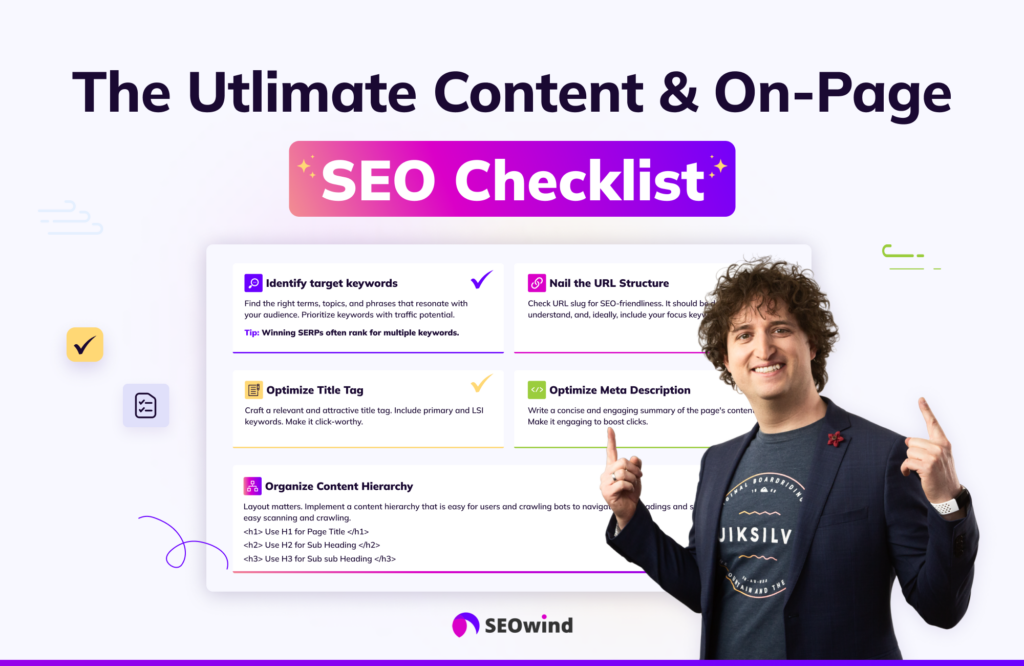
Pillar 5: Strategies for Promoting and Distributing SEO-Based Content

Creating valuable SEO content is half the battle. The other half lies in promoting and distributing your content effectively. Think of your blog post or webpage as an island and imagine how stranded it would be without bridges leading potential visitors to it.
Tactics for Attracting Backlinks and Increasing Online Visibility through Link-Building Strategies
One such swift bridge is a backlink strategy. High-quality backlinks from authoritative websites provide valuable referral traffic and signal to search engines that your content is trustworthy and relevant, boosting its ranking. Here’s the primary playbook:
- Create unique, engaging content that others naturally want to reference and link to.
- Reach out directly to influencers or industry authorities who might find your work useful. A simple note asking if they’d like exclusive early access can go a long way.
- Offer to write guest posts on related websites, including insightful conclusions that incentivize back-linking.
Remember, quality trumps quantity when it comes to backlinks. One well-regarded site linking to yours can do wonders compared to several low-quality ones.
Social Media Promotion Strategies to Amplify the Reach of SEO-Based Content
In addition to external sites linking back, you should use social media platforms for promotion. It frequently starts with posting links or truncated versions of your own work on Facebook, Twitter, LinkedIn, or Instagram based on what fits best with the platform’s communication style and audience demographic:
- Short infographics, snippets highlighting key points, or teasers play well on Pinterest/Instagram.
- Directly addressing questions and concerns drive engagement on Twitter/Facebook.
Guest Blogging Opportunities to Expand the Audience Base and Increase Brand Visibility
Another effective strategy to consider is guest blogging. Writing valuable posts on other sites helps cultivate relationships with industry influencers and exposes your brand and expertise to a new audience who might not have come across it otherwise. It can function doubly as an effective link-building method if the site allows author bylines or links. Large-scale brands like Moz prove this with their ‘YouMoz’ initiative, which invites others to their highly reputable blog.
Given that SEO content creation consists of so many moving parts, finding synergy between them all separates the good from the great. Promoting your content in the ways described above can be game-changing for its eventual success! Stay tuned for more tips to master SEO-based content strategies.
Measuring the Success of SEO-based Content:
When it comes to creating and implementing an SEO strategy, one thing is certain: we cannot manage what we can’t measure. Evaluating your efforts through data-driven key performance indicators (KPIs) is crucial to maximizing the efficiency and effectiveness of your SEO endeavors.
So, let’s dive into this critical process, focusing first on understanding KPIs for SEO content.
Tracking and Analyzing KPIs for SEO Content
Monitoring your online success involves maintaining a keen eye on select KPIs depending on the goals you’ve set for your website. Here are some example metrics that can be used as markers of progress:
- Organic Traffic: How many visitors does your site attract from unpaid search results?
- Rankings: How do specific keywords relevant to your business perform in search engine listings?
- Conversion rate: Which percentage of visitors engage in desirable actions (like purchasing a product or subscribing to a newsletter)?
- Bounce Rate: Are users sticking around or leaving almost immediately after arriving at a page?
The changes over time in these metrics give valuable insights into whether or not you’re getting closer to achieving your targeted outcomes.
Next, I’ll elaborate on available tools for monitoring organic search rankings, traffic, and conversions.
Utilizing Tools for Monitoring Organic Search Rankings, Traffic, and Conversions
There’s no shortage of digital tools designed to track SEO-related statistics. Here’s an overview of those that come highly recommended:
- Google Analytics: This platform provides comprehensive details about user behavior on your website, such as visitor demographics, time spent on pages, and conversion metrics.
- SEMRush: An all-in-one marketing toolkit suitable for analyzing keyword performance, including competitor research.
- Ahrefs: Noted mainly for its advanced backlink analysis capabilities, Ahrefs is great for benchmarking against the competition and discovering keyword opportunities.
Deploying such tools can offer a cutting-edge advantage when it comes to understanding and monitoring your organic search performance in real time.
Once all measurements have been established and observed, the next logical step is to make improvements. Let’s discuss adjusting and enhancing SEO content based on data-driven insights.
Adjusting and Improving SEO content based on Data-Driven Insights
SEO isn’t a static field. Optimizing your website should involve ongoing refinement based on the data available. Several improvements that might be necessary include:
- Keyword adjustments: Optimize new keywords or remove ineffective ones.
- Content Updates: Freshen updated information on pages or blogs.
- Technical SEO Updates: Improve site speed and the user experience factors or fix broken links.
- Backlink enhancements: Track down non-functional backlinks or identify new linking opportunities.
By adopting such an approach of constant improvement guided by credible data metrics, you set yourself up for sustained success.
Remember, each decision related to your SEO strategy should always be based on clear, quantifiable evidence rather than gut feelings. The insightful metric analysis garnered from meticulous tracking and savvy use of top-tier analytics tools will guide you to achieve favorable results.
The Future of SEO-Based Content

I have always placed a great emphasis on keeping pace with rapidly evolving trends. This principle holds true for SEO as well. Therefore, let’s look at what we can anticipate and adapt to ensure our SEO strategies remain effective in the future.
Exploring Emerging Trends in Search Engine Optimization and its Influence on Content Creation
Advancements happening today are already paving the way for exciting changes for SEO.
- Artificial Intelligence and Machine Learning: AI has begun to play a significant role in how search engines rank pages. Drawing from enormous datasets, machine learning algorithms evaluate factors such as user interaction, time spent on page, and bounce rates to judge the relevance and quality of content. For us creators, this calls for more naturally engaging content that hooks readers’ attention.
- Data Privacy Regulation: Consumer data privacy concerns are more prominent now than ever due to stricter regulations being imposed worldwide. Consequently, marketers must be transparent about their data usage practices while also using cookieless tracking methods to comply with these regulations.
- SERP Features: SERP features like featured snippets, local packs, or people also ask sections directly answer user queries without requiring them to click through to another web page. This increases competition to rank not just near the top but at position zero!
These trends will most certainly impact how we approach content creation. It’s no longer only about keyword optimization. We have to go above and beyond to craft experiences that captivate users while adhering strictly to ethical guidelines around consumer data use.
Adapting To New technologies such As Voice Search And Mobile Optimization For SEO Strategies
On a related note, emerging technologies offer exciting new channels for reaching potential audiences.
Firstly, voice search, powered by intelligent virtual assistants like Siri or Alexa, makes searching as simple as asking a question. Content that directly answers those questions in a conversational tone will have a competitive edge.
Secondly, mobile optimization enhances sites to ensure they function flawlessly on mobile devices. This is no longer optional but a basic necessity. Google’s mobile-first update already emphasizes the user experience on smaller screens, making it crucial for SEO strategies.
To thrive in this new landscape, we must let go of outdated practices and embrace these changes. By familiarizing ourselves with AI algorithms, understanding data privacy ethics, adopting SERP features, and tuning our content for voice search and mobile platforms, we can continue creating compelling SEO-based Content.
Your experiences with SEO content made by Chat GPT
Over the years, I’ve used a variety of tools to assist my work as a content writer. But none have been as fascinating and game-changing as chatbot models like Chat GPT. Let’s review what makes these AI models tick and how they can support your SEO efforts.
ChatGPT is a language model, not a knowledge model
The first thing you need to understand is that ChatGPT, at its core, is a language model. It excels at understanding language patterns, sentence structures, and syntax and can generate text that convincingly replicates a human-like writing style.
However, as advanced as the model may be, it’s not a knowledge model. It doesn’t know things or understand information the way humans do. Its ability to generate relevant text comes from being trained on diverse datasets collected from the internet.
While this distinction might seem arbitrary, knowing this can help users set realistic expectations and use the tool more efficiently. Understanding this also reinforces why you still play a crucial role in generating high-quality SEO-based content even when using an AI-writing assistant.
ChatGPT requires SEO input like keywords
Chatbot-powered models such as GPT-3 perform marvelous feats when given specific instructions or inputs. For instance, if you want to create content optimized for search engines — think blog posts that target keyword density — the first step entails giving clear guidelines to these AI models about your preferred keywords or phrases.
One unique strength of these tools is their capacity to incorporate provided keywords naturally into sentences while maintaining readability, an essential attribute for successful SEO content.
However, given their algorithmic design, they are less likely to spontaneously generate astutely optimized output without direct user input regarding specific SEO strategies.
Moreover, we need to remain cognizant that SEO strategies are dynamic, and what worked yesterday may not work tomorrow. AI models like ChatGPT won’t know the latest SEO trends unless these new rules are integrated into their training datasets.
Consequentially, you remain integral in guiding these AI writing assistants and staying abreast of evolving SEO techniques. As a user of Chat GPT, I’ve learned to implement my expertise by giving it clear instructions and essential keywords for generating well-optimized content.
While language models like Chat GPT have transformed how we approach content creation, the need for human involvement and knowledge concerning current SEO best practices continues to be indispensable to leveraging these tools successfully.
How SEOwind can help you create SEO-based content
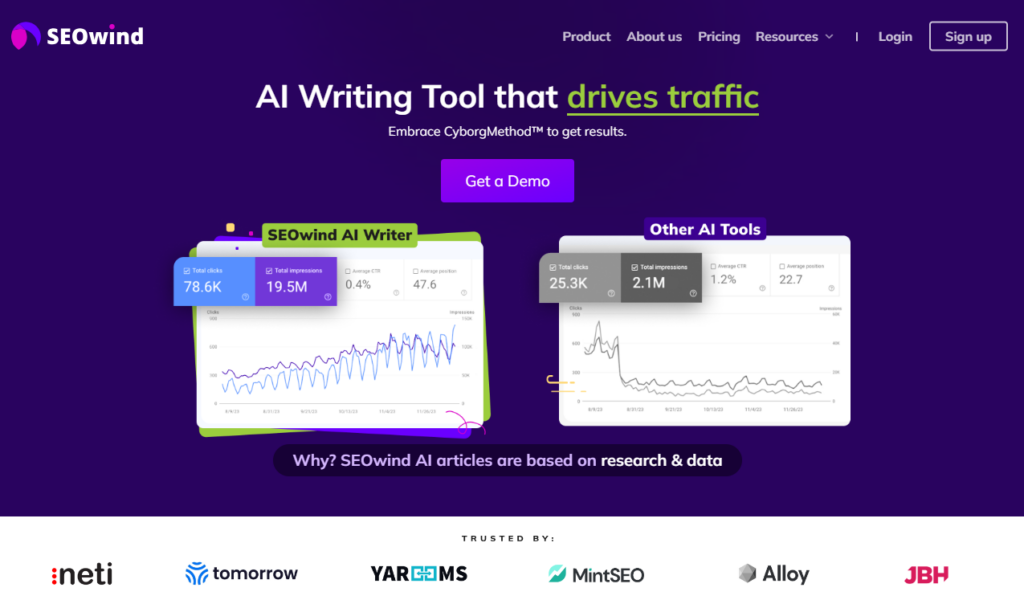
Creating compelling, search-optimized content might seem like a daunting task. Be it uncovering relevant keywords, crafting effective headlines, or optimizing your on-page elements, the process requires meticulous attention to detail.
This is where SEOwind steps in as your competent partner to streamline the entire SEO content creation process for you.
In-depth Content and Keyword Research
The foundation of any potent SEO strategy is thorough research. SEOwind possesses robust capabilities that facilitate comprehensive keyword exploration and competitive analysis. It aids in finding long-tail keywords that cater to your potential customers’ search intent. It conducts an inclusive audit of your competition’s keyword usage so you can identify unique growth opportunities.
Unique Content Outlines
Beating around the bush doesn’t work with today’s tech-savvy audience; Instead, they crave information-rich and precise content. Anatomy matters! SEOwind assists in creating targeted content outlines that contain relevant details while omitting fluff. This approach keeps readers hooked and enables better communication of your brand message.
Language Versatility
With its multilingual feature support that includes English, Spanish, Portuguese, French, and German, SEOwind ensures that language isn’t a barrier when resonating with diverse target audiences. You can reach more users with culturally tailored content across different geographies by choosing the preferred language!
In addition, the tool offers features designed to invoke human connection. The CyborgMethod™ encourages cooperation between humans and AI and helps create engaging copy that genuinely feels human-written despite being machine-generated. It’s like having the best of both worlds!
SEOwind’s focus on maintaining quality throughout scaled-up operations proves how the strategic deployment of services provided by SEOwind can dramatically enhance your website’s visibility in organic searches, thereby driving traffic to your website.
With integrated AI making each process more efficient, SEOwind emerges as the perfect tool for creating high-quality SEO-based content that aligns with your vision and communicates with your audience in their language.
So, if you’re looking for greater visibility online, an increased user base, and higher revenue, harnessing the power of tools like SEOwind is a significant first step. So why wait? Dive into the fast-paced world of SEO content creation with SEOwind today!
Common Questions Regarding SEO-based Content
What is the difference between SEO and non-SEO content?
Search Engine Optimization (SEO)-based content and non-SEO content can be differentiated based on how they’re designed and their ultimate purpose.
SEO-based content is crafted with both human readers and search engines in mind. The goal is to rank high on search engine result pages (SERPs), driving organic traffic to your site while providing valuable information to your audience.
On the other hand, non-SEO content primarily caters to readers without aiming for any specific search engine visibility. While it can still be engaging and valuable, its reach may be limited due to a lack of optimization.
Writing for SEO ensures your captivating content doesn’t get lost in cyberspace and reaches as many interested internet wanderers as possible!
Should my clients write their own SEO content?
Clients combining their industry expertise with a basic awareness of how to write SEO content might sound like an effective strategy. However, it has several potential downsides, including a lack of time or writing talent as well as an insufficient understanding of optimization requirements.
That being said, every client’s capacity is different. If one feels confident about staying updated with Google’s ever-changing algorithms or is keen on learning keyword research tools, that’s fantastic! But remember that successful SEO content goes beyond including a keyword here and there.
It’s recommended to acquaint clients with these realities before they commit to writing their SEO content. Often, it’s more beneficial for them to contribute subject matter expertise and let SEO professionals handle the optimization.
What’s your process for planning SEO content?
Creating a roadmap for SEO content begins with identifying business goals, followed by comprehensive keyword research, as these will heavily shape your content direction. Next, understanding search intent guides title creation, laying a foundation that satisfies user queries and search engine algorithms.
Having done that groundwork, I create an outline of subtopics and key points, ensuring each element remains systematic and cohesive. Besides providing valuable information, I emphasize crafting compelling introductions built on engaging anecdotes or captivating data to set the tone right from the start!
The next step involves shaping raw ideas into a persuasive copy that contains relevant keywords while maintaining natural readability. Once this is achieved, paragraphs are formatted neatly and broken up using relevant headers to ensure accessibility.
Finally, I double-check meta tags, URLs, and alt text before publishing any piece. This brief overview ought to give you some initial insights into what strategic SEO content planning can look like.


